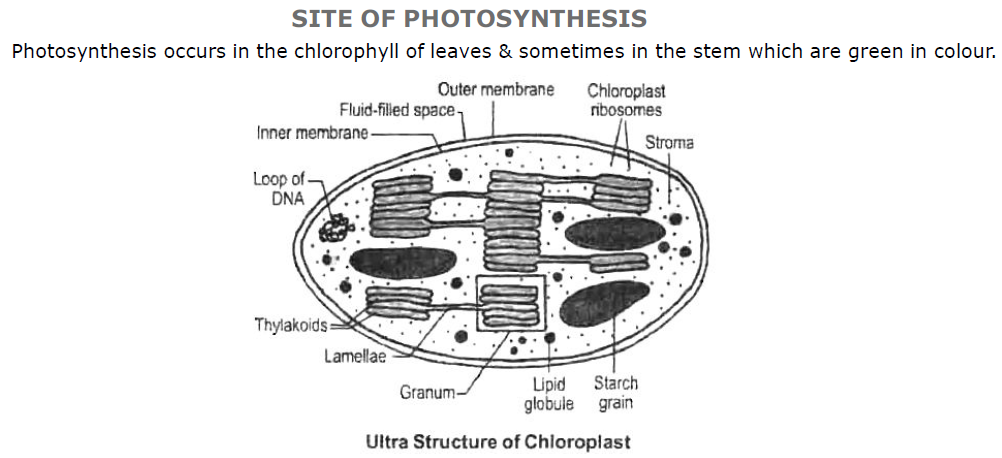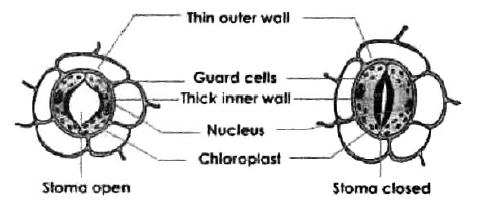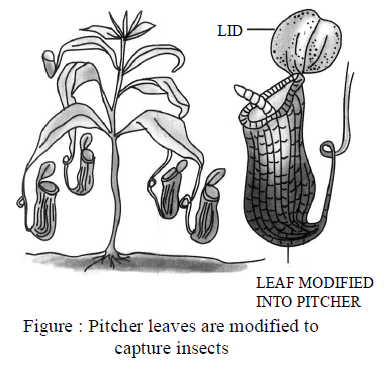Download Class 7 Science Nutrition in Plants Notes Set B in PDF format. All Revision notes for Class 7 Science have been designed as per the latest syllabus and updated chapters given in your textbook for Science in Class 7. Our teachers have designed these concept notes for the benefit of Class 7 students. You should use these chapter wise notes for revision on daily basis. These study notes can also be used for learning each chapter and its important and difficult topics or revision just before your exams to help you get better scores in upcoming examinations, You can also use Printable notes for Class 7 Science for faster revision of difficult topics and get higher rank. After reading these notes also refer to MCQ questions for Class 7 Science given on studiestoday
Revision Notes for Class 7 Science Chapter 1 Nutrition in Plants
Class 7 Science students should refer to the following concepts and notes for Chapter 1 Nutrition in Plants in Class 7. These exam notes for Class 7 Science will be very useful for upcoming class tests and examinations and help you to score good marks
Chapter 1 Nutrition in Plants Notes Class 7 Science
Plants play role of producers in nature. are producers, which produce food for all living organic. They utilize sun’s radiant energy & convert into chemical energy. In this way, they also plays role of converter. Plants use sunlight in photosynthesis. During photosynthesis in the presence of sunlight CO 2 & H 2 O convert in to carbohydrate & O 2 molecules.
MECHANISM OF PHOTOSYNTHESIS
![]()
- Steps of photosynthesis :
- Chlorophyll traps the sunlight.
- CO2 & water molecule used as raw material.
- Now the chlorophyll convert the raw material into carbohydrate.
- Oxygen is generated as a by product in this process.
REQUIREMENT OF PHOTOSYNTHESIS
Green plants need the following things to prepare their own food :
- Carbon Dioxide : Plants take up carbon dioxide from the atmospheric air through stomata present on the undersurface of the leaves. Guard cells around stomata regulate their opening and closing.
- Chlorophyll : It is the green pigment presents in the leaf. The green colour of leaves is due to the presence of chlorophyll. It is usually present in special cell organelle called chloroplast. Chlorophyll captures solar energy during photosynthesis.
- Sunlight : Sunlight comes from the sun. It is essential as it provides the energy required for the reaction.
- Water and Minerals : Roots of the plants absorb water along with minerals from the soil and transport them to the leaves for photosynthesis.

- Importance of photosynthesis :
- It is primary source of food production for all other living organisms.
- It maintain balance oxygen & CO2 in the atmosphere.

NUTRITION IN NON GREEN PLANTS
Non green plants like bacteria & fungi do not contain chlorophyll. So they cannot prepare their food by photosynthesis. These types of plants are heterotrophic plants.

(1) Parasites : Plants which depends on other living organism for their nutritional requirement known as parasitic plants. Dodder (Amarbel) is a plant parasite which produces special sucking roots called haustoria. For absorption of food from the host plant.
(2) Saprophytes : Plants which depends on dead organic matter for their nutrition, known as saprophytic plants. For example – Bacteria & fungi.
(3) Carnivorous & insectivorous plants : Some plants also take food just like animals. Their food consists of small insects. For example – Pitcher plants.
In a pitcher plant leaf is modified into a pitcher like structure when any insects sits on it, the lid is closed & the insect is trapped in pitcher. It is then digested by the secretion of enzymes.

(4) Symbiosis : It is a partnership between two organisms in which both partner get benefited from each other.
For example : Lichen. Lichen is a combination of an alga & a fungus. In which, the fungus provides water & minerals to the alga whereas the alga supplies organic food to fungus.
HETEROTROPHIC NUTRITION IN ANIMAL
Animals and non-green plants like fungi, etc. cannot manufacture their own food. For their food, they depend upon green plants, directly or indirectly. Therefore, they are called heterotopous and their mode of nutrition is known as heterotrophic nutrition.

All animals are divided into three categories on the basis of their eating habits :
- Herbivorous Animals : Animals which feed directly on plants are called herbivorous animals or herbivores.
Examples are cow, buffalo, goat, etc.
- Carnivorous Animals : Animals which eat the flesh of other animals are called carnivorous animals or carnivores. Examples are lion, tiger, etc.
- Omnivorous Animals : Animals which eat both plants and flesh of other animals are called omnivorous animals or omnivorous. Examples are human beings, pig, crow, cockroach, etc.
Question: Rhizobium is a good example of –
a) insectivorous
b) symbiosis
c) parasitic
d) none of these
Answer: b
Question: Which one of the following is a parasite ?
a) Mushroom
b) Fungi
c) Dodder
d) Pitcher’s plant
Answer: c
Question: During photosynthesis the oxygen in glucose comes from
a) water
b) carbon dioxide
c) both from water and carbon dioxide
d) oxygen in air
Answer: a
Question: The source of O₂ liberated in photosynthesis is
a) photosynthetic enzyme
b) carbohydrate present in leaf
c) water
d) carbon dioxide
Answer: c
Question: The life processes that provide energy are
a) nutrition
b) respiration
c) both nutrition and respiration
d) response to stimuli
Answer: c
Question: The plant that feeds & traps on insects is –
a) Drosera
b) Sunflower
c) Cuscuta
d) Mango
Answer: a
Question: Which of the following wavelength of light is absorbed maximum for photosynthesis?
a) Red light
b) Blue light
c) Green light
d) Yellow light
Answer: b
Question: The green pigment in the leaves is called –
a) Chlorophyll
b) Anthocyanin
c) Chloroplast
d) None
Answer: a
Question: Autotrophic nutrition found only in –
a) plants
b) animals
c) both
d) none
Answer: a
Question: Cuscuta is an example of –
a) autotroph
b) parasite
c) saprophyte
d) host
Answer: b
Question: Of the following identify the carnivorous plant
a) Pitcher plant
b) Venus fly trap
c) Both of them
d) None of them
Answer: c
Question: CO₂ & O₂ balance in atmosphere is due to –
a) Photorespiration
b) Photosynthesis
c) Respiration
d) Leaf anatomy
Answer: b
Question: An example of an autotrophic plant is ……..
a) Mushrooom
b) Mould
c) Dodder
d) Neem
Answer: d
Question: An example of a saprophytic plant is ……
a) Dodder
b) Monotropa
c) Mushroom
d) All of them
Answer: c
Question: Raw materials for photosynthesis :
a) Carbon dioxide
b) Water
c) Sunlight
d) All of them
Answer: d
Question: Which of these is not necessary for photosynthesis?
a) carbon dioxide
b) chlorophyll
c) light
d) nitrogen
Answer: d
Question: Association of two different organisms in which both are benefited is called –
a) symbiosis
b) nutrition
c) saprophytic
d) parasitic
Answer: a
Question: Grana refers to
a) glucolysis of glucose
b) by-product of photosynthesis
c) stacks of thylakoids
d) stacks of quantasomes
Answer: c
Question: The plant that feeds and traps on insects is –
a) venus-fly trap
b) cuscuta
c) sunflower
d) none of these
Answer: a
Question: CO₂ and O₂ balance in atmosphere is due to
a) photorespiration
b) photosynthesis
c) respiration
d) leaf anatomy
Answer: b
Question: Chlorophyll in chloroplasts is located in –
a) grana
b) pyrenoid
c) stroma
d) none of these
Answer: a
Question: ATP formation during photosynthesis is known as
a) phosphorylation
b) photophosphorylation
c) oxidative phosphorylation
d) substrate level phosphorylation
Answer: b
Question: Which of the following is the least effective in photosynthesis?
a) Red light
b) Blue light
c) Green light
d) Violet
Answer: c
Question: Dark reaction of photosynthesis occurs in
a) Grana
b) Stroma
c) Matrix
d) Cytoplasm
Answer: b
Question: The assimilatory power in photosynthesis is
a) ATP
b) NADPH
c) ATP and NADPH₂
d) ATP, NADPH and CO₂
Answer: c
Question: Holophytic nutrition means-
a) autotrophism
b) heterotrophism
c) symbiotism
d) parasitism
Answer: a
Question: Chlorophyll is present
a) in the grana of chloroplast
b) on the surface of chloroplast
c) in the stroma of chloroplast
d) none of these
Answer: a
Question: In bacterial photosynthesis, the hydrogen donor is –
a) H₂O
b) H₂SO₄
c) NH₃
d) H₂S
Answer: d
Question: Mushroom, Rhizopus and Yeast are
a) Chemosynthetic
b) Parasitic
c) Holozoic
d) Saprophytic
Answer: d
Question: Autotrophic nutrition occurs in
a) Fungi
b) Plants
c) Some protists and prokaryotes
d) Both b and c
Answer: d
Question: Chlorophyll cannot absorb one of the following
a) red light
b) blue light
c) blue and red light
d) green light
Answer: d
Question: The oxygen in photosynthesis is released from –
a) CO₂
b) H₂O
c) Carbohydrate
d) Chlorophyll
Answer: b
Question: The raw materials for photosynthesis are –
a) CO₂ & O₂
b) sunlight and CO₂
c) water and chlorophyll
d) CO₂ and water
Answer: d
Question: A specific function of light energy in the process of photosynthesis is to
a) activate chlorophyll
b) split water
c) synthesis glucose
d) reduce CO₂
Answer: a
Question: Dark reaction of photosynthesis occurs in the
a) stroma of the chloroplast outside the lamellae
b) space between the two membranes of the chloroplast
c) membranes of the stroma lamellae
d) thylakoid membrane of the grana
Answer: a
Question: Photosynthesis proceeds in sequence of –
a) Dark phase and light phase
b) Light phase alone
c) Light phase and dark phase
d) Dark phase alone
Answer: c
Question: In which part of chloroplast light reaction of photosynthesis occurs?
a) Grana
b) Stroma
c) Matrix
d) All the above
Answer: a
Question: Dark reaction in photosynthesis is called so because
a) it does not require light energy
b) cannot occur during daytime
c) occurs more rapidly at night
d) it can also occur in darkness
Answer: a
CBSE Class 7 Science Chapter 1 Nutrition in Plants Notes
We hope you liked the above notes for topic Chapter 1 Nutrition in Plants which has been designed as per the latest syllabus for Class 7 Science released by CBSE. Students of Class 7 should download and practice the above notes for Class 7 Science regularly. All revision notes have been designed for Science by referring to the most important topics which the students should learn to get better marks in examinations. Our team of expert teachers have referred to the NCERT book for Class 7 Science to design the Science Class 7 notes. After reading the notes which have been developed as per the latest books also refer to the NCERT solutions for Class 7 Science provided by our teachers. We have also provided a lot of MCQ questions for Class 7 Science in the notes so that you can learn the concepts and also solve questions relating to the topics. We have also provided a lot of Worksheets for Class 7 Science which you can use to further make yourself stronger in Science.
You can download notes for Class 7 Science Chapter 1 Nutrition in Plants for latest academic session from StudiesToday.com
Yes, the notes issued for Class 7 Science Chapter 1 Nutrition in Plants have been made available here for latest CBSE session
There is no charge for the notes for CBSE Class 7 Science Chapter 1 Nutrition in Plants, you can download everything free of charge
www.studiestoday.com is the best website from which you can download latest notes for Chapter 1 Nutrition in Plants Science Class 7
Come to StudiesToday.com to get best quality topic wise notes for Class 7 Science Chapter 1 Nutrition in Plants

